Tenmae and Temae
A procedure of preparing and making a bowl of tea is called a ten-mae, 點前, offer-fore. The Kanji, 點, is also written 点前, using 点, the simplification of the Kanji 點. Other preparations, are called te-mae, 手前, hand-fore.
An older version of the Kanji for ten is 㸃, which more clearly separates the five aspects of the character. The Kanji may be seen as being composed of five Kanji representing the Go-rin, 五輪, Five rings, metaphysical principles.
The following is an analysis of the Kanji 㸃.
Uranau,卜, to divine; combines a Yō line and an In line.
Kuchi, 口, mouth; symbolic of differentiated In and Yō.
Ta, 田, ricefield; lines represent the dikes of a water-filled ricefield.
Tsuchi, 土, earth.
Hi, 火, fire.
The other reference to preparation, te-mae, 手前, includes the word for ‘hand’. Originally, temae referred to a person or an object before oneself. It is abbreviated to teme, meaning ‘you’ (before me). The human hand is the source for the sizes of various utensils used in Chanoyu. The cha-wan, 茶碗, tea-bowl, emulates both hands cupped to hold water to drink, which was the origin of the conical Chinese Ten-moku, 天目, Heaven-eye, chawan. This is a known concept.
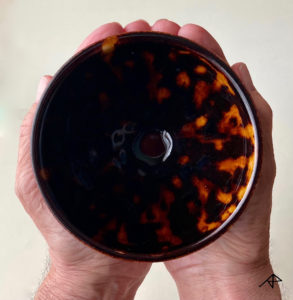
Most of the utensils used in the Japanese Tea ceremony are handled with one or both hands. Ideally, each object should be handled with both hands, uniting In and Yō, which involves the entire human being. The chawan is handled with both hands. The Tenmoku bowl is cupped with both hands.
There are other utensils that may also be physically associated with the human hand, and hands. And the manifestations of hand gestures which, in Sanskrit, are mudras: Japanese in-zō, 印相, seal-aspect.
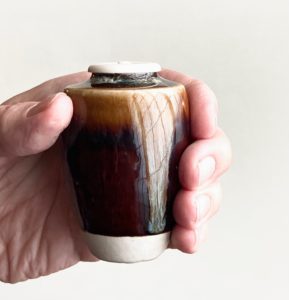
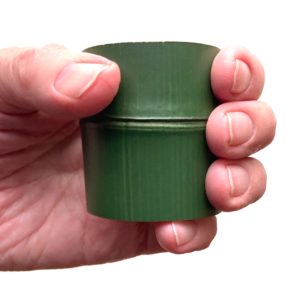
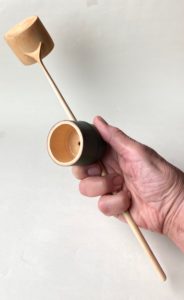
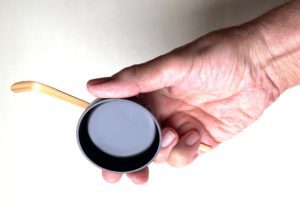
The hi-shaku, 柄杓, handle-ladle, is held with the fourth and little fingers; the cha-shaku, 茶杓, tea-scoop, is held with the fourth and little fingers.
The futaoki is upside down, the hishaku cup is right side up; the natsume, 棗, jujube, lid is right side up, the chashaku is upside down.
The futaoki is related to incense (the ho-ya gō-ro, 火舎香炉, fire-house incense-hearth, futaoki in particular) for the spirit, and the natsume is related to tea for the body. Both are medicines.
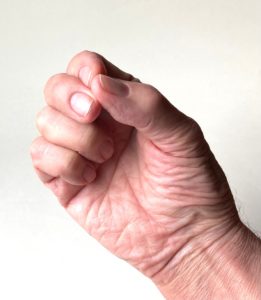
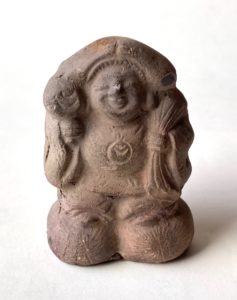
The manner in which the hishaku and chashaku are held, may be related to a mudra that is associated with Dai-koku-ten, 大黒天, Great-black-heaven, the god of wealth. Daikoku originated with the Indian god of wealth, Kubera. When the thumb and two fingers are separated, they hold various objects. Daikoku holds in his right hand the ko-zuchi, 小槌, small-hammer, of good fortune.
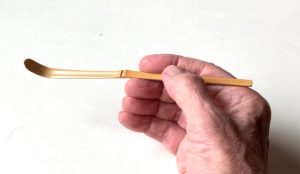
The chashaku touches the index finger is two places. According to acupuncture concepts, the index finger is identified with the lung, and the lung is the source of Wind, and the chashaku according to the Ekikyō is identified with Wind, Son. The Kanji sun 寸is also read son. The chashaku is held at approximately a 45° angle, which corresponds with a diagonal line from the northwest, Ken, Heaven, to the southeast, the location of Son, Wind, and Fugen Bosatsu.
Fugen is in the same southeast location in the Dainichi Center of the Taizōkai Mandara, 胎蔵界曼荼羅, Womb-keep-world Wide-weed-spread. Fugen rides the white elephant, that has six tusks. The ivory chashaku length is six sun. Fugen holds a lotus.
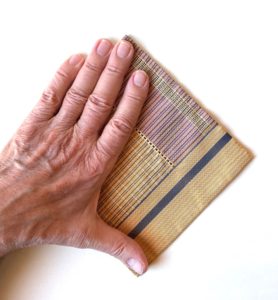
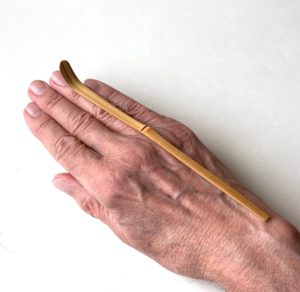
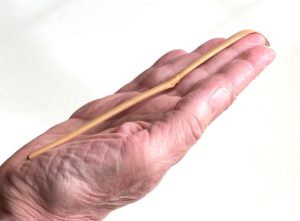
Tea is a medicine, kusuri, 薬. Perhaps there is a connection between the chashaku and a finger. The fourth finger, the so-called ring finger of the hand, in Japanese is called the kusuri yubi, 薬指, medicine finger, and is also read yaku–shi. It is said to be the cleanest of the fingers, as it is not used very much. Ancient Asian medicine was often in powdered form, and was mixed and dispensed with the medicine finger and nail. In anatomy, the fourth finger is called the digitus medicinalis. In acupuncture, the medicine finger is associated with the lungs, but can influence the heart. Other early cultures believed that the fourth finger has a vein that goes directly to the heart, which leads to love, and then adding a ring to show its continuousness.
In acupuncture, there are four points at the base of the fingers of both hands called hachi-ja, 八邪, eight-wicked. A nakabushi chashaku placed on the back of the hand, locates the fushi near both of the points on either side of the fourth, ‘kusuri’ finger. The fourth finger is identified with the very important line called the san-shō, 三焦, three-burn, san jiao; triple heater; the functional metabolic organ in Chinese medicine. It is called one of the six dragons, and focuses influence above the diaphragm, above the upper abdomen, and below the navel, the three areas that generate heat to maintain body temperature.
The Hands of Amida Nyorai
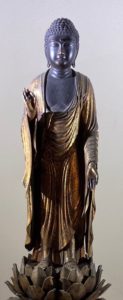
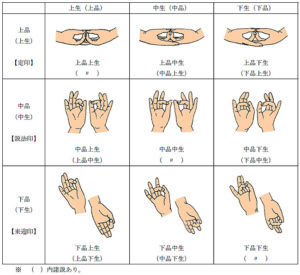
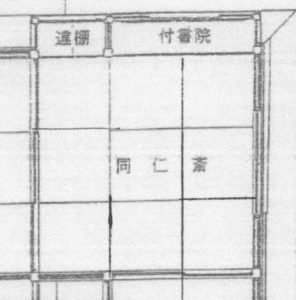
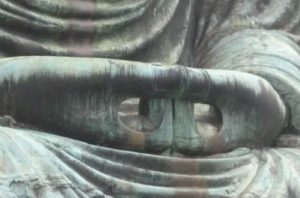
The hands of the great Amida Buddha in Kamakura, are held in the mudra identified as Jō-no-jō, 上の上, Upper-of-upper, the highest of the nine mudras. Important feature is that the underside of both thumbs touch the sides of the fore fingers, which is the manner in which the chashaku and the hishaku are held. Also, and less obvious, is that the middle finger of the right hand is below the back of the left hand. When the Jō-no-jō gesture is opened, and the hands are held in the mudra of Rai-gō, 来迎, Come-greet, welcoming, this is where Amida beckons souls to his western paradise. The nine mudras may be identified with the nine squares of the yo-jō-han, 四畳半, four-mat-half, Tearoom. This may be most evident in the yojōhan of Dō-jin-sai,同仁斎,Equal-benevolence-abstain, Tea room of the Tō-gu-dō, 東求堂, East-quest-hall, at Gin-kaku-ji, 銀閣寺, Silver-pavilion-temple, which was dedicated to Amida and the Jō-do-shū, 浄土宗, Pure-land-sect of Buddhism.
There are two shaku, 尺, span, that are used in traditional Japanese culture; kane-jaku, 曲尺, bend-span, approximately one foot of twelve inches, and kujira-jaku, 鯨尺, whale-span, is approximately 14 7/8 inches. The standard shaku is the kane-jaku, although artists who traditionally use the kujira-jaku, continue to do so. The Japanese government decreed that measurements are to be reckoned in centimeters.
The measurement of the kane shaku, 尺, has been widely interpreted as to its length. Lengths were determined by the span of the human hand. One of the lengths is the distance between the outstretched thumb and middle finger, while another is the distance between the thumb and the index finger.
The index finger in Japanese is called the sashi-yubi, 差し指, indicate-finger, and when pointing at something is called hito-sashi-yubi, 人差し指, person-indicate-finger. The word shaku, 尺, is also read sashi.
The Hands of Dainichi Nyorai.
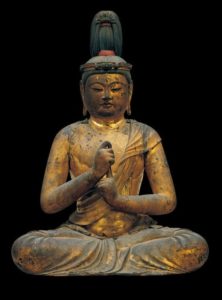
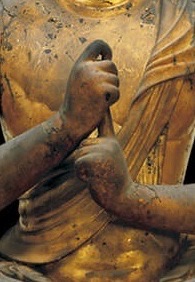
Figure of Dainichi seated, and with his hands in the mudra of Chi-ken-in, 智拳印, Wisdom-fist-seal.
The distinctive mudra of Dainichi is called Chi-ken-in, 智拳印, wisdom-fist-seal. The index fingers of both hands are joined together, the right hand grasping the index finger of the left hand. Although the manner in which the hands are depicted may differ from image to image when joined together, the important aspect of the mudra is the joining the tips of the index fingers, which figuratively unites them, creating one. The joined ‘one’ index fingers leaves the other fingers and thumbs creating eight surrounding individuals. This may be regarded as one and eight, 1.8. Dainichi is ‘one’ with eight other deities who are aspects of Dainichi. In Japanese yoga theory, the index finger is identified with Kū, 空, Void, which is the highest of the Go-rin, 五輪, Five-principles, which are identified with each of the five fingers. The Chikenin mudra of Dainichi unifies the dual aspects of universe.
